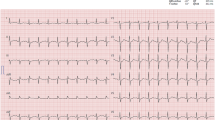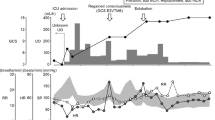Abstract
Introduction
Valproic acid (VPA) toxicity commonly results in a self-limited state of CNS depression that is managed with supportive care and levocarnitine. In massive overdose, patients can develop toxic encephalopathy, shock, multisystem organ failure, and death. We present a case with relevant toxicokinetics of a patient presenting with a profoundly elevated VPA concentration resulting in survival, treated with supportive care including high-dose continuous venovenous hemodiafiltration (CVVHDF).
Case Report
A 17-year-old female presented to an emergency department after being found unresponsive at home with concern for massive VPA ingestion. She arrived obtunded and hypotensive with initial VPA concentration of 2226 mg/L, estimated 9 h post-ingestion. Her early hospital course was marked by hypotension requiring multiple vasopressors, and her workup was notable for multiple severe metabolic derangements. High-dose CVVHDF was initiated upon transfer to a tertiary children’s hospital with the aim to enhance VPA removal and normalize metabolic derangements. At that time, her VPA concentration was 1071 mg/L. Apparent half-life of VPA improved modestly with extracorporeal treatment, but her metabolic derangements and hemodynamic instability corrected rapidly. Her clinical course was complicated by necrotizing pancreatitis, pancytopenia requiring transfusions of multiple cell lines, coma, and seizures. She ultimately recovered with normal neurological function.

Similar content being viewed by others
References
Gummin D, Mowry J, Beuhler M, et al. 2019 Annual Report of the American Association of Poison Control Centers’ National Poison Data System (NPDS): 37th Annual Report. Clin Toxicol (Philadelphia, Pa). 2020;58(12):1360–541.
Isbister GK, Balit CR, Whyte IM, Dawson A. Valproate overdose: a comparative cohort study of self poisonings. Br J Clin Pharmacol. 2003;55(4):398–404. https://doi.org/10.1046/j.1365-2125.2003.01772.x.
Spiller HA, Krenzelok EP, Klein-Schwartz W, Winter ML, Weber JA, Sollee DR, Bangh SA. Multicenter case series of valproic acid ingestion: serum concentrations and toxicity. J Toxicol Clin Toxicol. 2000;38(7):755–60. https://doi.org/10.1081/CLT-100102388.
Ghannoum M, Laliberté M, Nolin TD, Mactier R, Lavergne V, Hoffman RS, Gosselin S, Anseeuw K, Bhalla A, Burdmann EA, Calello DP, Dargan PI, Decker BS, Galvao TF, Goldfarb DS, Hoegberg LC, Juurlink DN, Li Y, Liu KD, … Yates C. Extracorporeal treatment for valproic acid poisoning: systematic review and recommendations from the EXTRIP workgroup. Clin Toxicol 2015;53(5):454–465. https://doi.org/10.3109/15563650.2015.1035441
Connacher AA, Macnab MS, Moody JP. Fatality due to massive overdose of sodium valproate. Scott Med J. 1987;32:85–6.
Muñiz AE. Valproic acid overdose review of a case with electrocardiographic changes. J Emerg Med. 2017;53(3):333–8. https://doi.org/10.1016/j.jemermed.2016.07.017.
Patrick KA, Jarriel JT, Hieger MA. Pancreatic pseudocyst due to acute valproic acid overdose. Am J Ther. 2018;25(5):E584–5. https://doi.org/10.1097/MJT.0000000000000684.
Ray S, Khamrui S, Kataria M, Biswas J, Saha S. Valproic acid-induced severe acute pancreatitis with pseudocyst formation: report of a case. Cureus. 2015;7(8):5–10. https://doi.org/10.7759/cureus.297.
Sztajnkrycer MD. Valproic acid toxicity: overview and management. J Toxicol Clin Toxicol. 2002;40(6):789–801. https://doi.org/10.1081/CLT-120014645.
van den Broek MPH, Sikma MA, Ververs TF, Meulenbelt J. Severe valproic acid intoxication: case study on the unbound fraction and the applicability of extracorporeal elimination. Eur J Emerg Med. 2009;16(6):330–2. https://doi.org/10.1097/MEJ.0b013e32832c7b18.
Funding
None
Consent for publication of this case was obtained and provided to the journal in accordance with JMT policy.
Author information
Authors and Affiliations
Corresponding author
Ethics declarations
Conflicts of Interest
None.
Additional information
Supervising Editor: Andis Graudins, MB BS, Ph D.
Publisher's Note
Springer Nature remains neutral with regard to jurisdictional claims in published maps and institutional affiliations.
Previous presentations: Data in this manuscript were previously presented at the North American Congress of Clinical Toxicology (NACCT) in October 2021.
Rights and permissions
About this article
Cite this article
Comstock, G., Kilgallon, K., Wang, G.S. et al. Management and Associated Toxicokinetics of Massive Valproic Acid Ingestion with High Flow Continuous Venovenous Hemodiafiltration. J. Med. Toxicol. 18, 239–242 (2022). https://doi.org/10.1007/s13181-022-00881-8
Received:
Revised:
Accepted:
Published:
Issue Date:
DOI: https://doi.org/10.1007/s13181-022-00881-8




